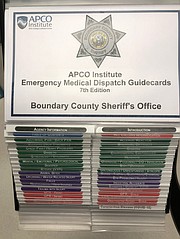Dispatch system could save lives
TONIA BROOKS | Hagadone News Network | UPDATED 5 years, 8 months AGO
The Boundary County Sheriff’s Office has a new tool.
The 911, Emergency Medical Dispatch (EMD) system has recently been added to the dispatch office to improve upon and help callers with medical or trauma related situations until professional help arrives.
Emergency communications have come a long way over the past 52 years. The first 911 call was made in 1968, by Alabama Senator, Rankin Fite.
It wasn’t until 1973 when the White House issued national policy and encouraged nationwide adoption of the 911 system. 911 is also used as the primary emergency communications number in Canada.
While Boundary County residents have had access to a 911 emergency communications system, people will now be able to receive instructions from dispatchers to help victims, which could ultimately help increase positive prognoses of those in danger.
“In the past, if someone called 911 and reported a person possibly having a heart attack, dispatch would have just dispatched the ambulance and law enforcement to their location,” explained Boundary County Sheriff Dave Kramer. “With EMD, the dispatcher will still be quickly dispatching the same resources, but now they will also be able to use their guidecards and give the caller directions on how to perform CPR while help is on its way.”
According to the Boundary County Sheriff’s Office press release, “Working in partnership with Boundary Ambulance, this has been a goal of Sheriff Kramer’s to add EMD as another way to help the community.”
“In the case of cardiac arrest the survival window is very limited, and CPR instructions given by Emergency Medical Dispatchers, prior to the arrival of paramedics and EMTs, may be the deciding factor between whether the patient lives or dies,” said Drew Rinella, paramedic captain of operations for Boundary Ambulance. “The same condition exists for any time sensitive emergency such as choking or traumatic injury.”
Boundary County Sheriff’s Office also partnered with their counterparts in Bonner County to receive training and implementation protocol. In addition, the Medical Advisor of Boundary Ambulance reviewed the informative medical guide cards of which dispatchers would be referring to in cases of medical calls.
“Adding this service for Boundary County is another life-saving skill that your trained Communications Specialists can provide before any first responders are able to be on scene,” said Crystal Denton, the 911 supervisor for the Boundary County Sheriff’s Office.”
“We are very thankful to Bonner County 911 who provided the certified instructors to train our dispatchers on this program,” Kramer said in the press release. “Without this training or program, dispatchers were not able to give any medical direction to someone on the other end of a call. With this system now, dispatchers can turn to a medical guidecard and read instructions to the caller on things that can be done while medical help is on its way.”
The Association of Public-Safety Communications (APCO) provided expertise and assistance to Boundary County Sheriff’s Office in the creation of the emergency medical dispatch guidelines. APCO’s training established classification and triage parameters for dispatchers to accurately and efficiently help callers in the community.
“The time between the emergency and an ambulance arriving is critical,” said Boundary Ambulance Chief Jeff Lindsey. “Having a trained person to provide life-saving instructions is crucial in improving prehospital survivability of medical emergencies.”
According to Rinella, “The life-saving potential of the pre-arrival instructions — given by dispatchers to patients and bystanders — is obvious.”
The guidecards cover a multitude of medical issues and have been updated for responding to issues relating to the COVID-19 pandemic. The COVID-19 pandemic has initiated a need for dispatchers to ask questions related to the virus for any call that a first responder may be dispatched to.
“Emergency Medical Dispatchers are our first line of defense against COVID-19, protecting emergency responders by screening callers for illness symptoms and other risk factors such as recent travel,” said Rinella. “Using this information gathered by EMDs, responders are then able to select the appropriate types of personal protective equipment to wear prior to patient contact.”
Boundary County Sheriff’s Office dispatch asks that callers take into consideration the possibility of increased hold time waits when calling 911.
“While most of the time we are able to have two dispatchers on at a time, with this added responsibility you may be asked to hold longer then usual or be advised we will have someone call you back if the dispatcher is instructing a caller in a life-threatening emergency at the time of your call,” said Denton. “Please be aware of this, and know that we will follow through once the emergency has ended.”
“We have a great group of professional dispatchers that are constantly going above and beyond to keep our community safe and all of the first responders that they dispatch for,” said Kramer. “The Sheriff’s Dispatch provides dispatch for all of our local first responders, law enforcement, fire, and medical, and handles all of the 911 calls and monitors the jail.”
Kramer asks callers that when they call 911 and speak with a dispatcher that people remember to thank them for keeping our community and first responders safe.
ARTICLES BY TONIA BROOKS

Second Harvest food distribution is July 30
BONNERS FERRY — From 11 a.m. to 1 p.m., on Thursday, July 30, Second Harvest Inland Empire emergency food distributors will be conducting another drive through food distribution at the fairgrounds.
Commissioners discuss use of CARES Act money
BONNERS FERRY — A lot was accomplished for the first week of July among the Boundary County Commissioners.

Addressing the lack of affordable housing
BONNERS FERRY — The estimated median household income for Bonners Ferry is found to be $31,724, compared to $52,225 for the rest of Idaho, yet it could be argued that housing prices are similar to that of places with higher income opportunities.



